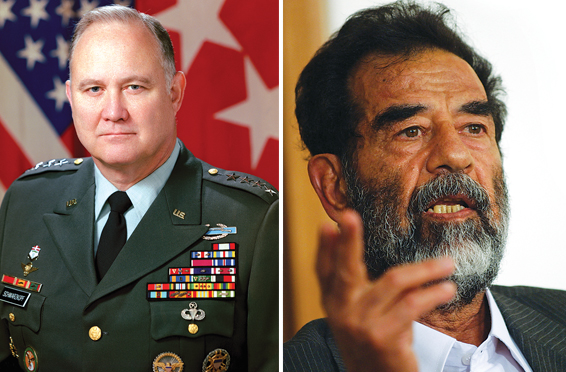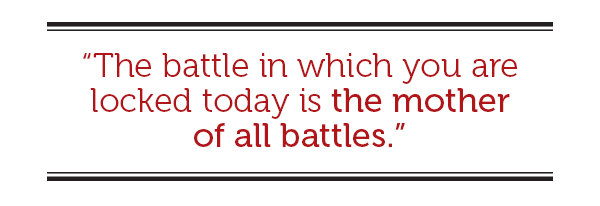

When placed in command, take charge.” This was more than just a catchy quote by General Norman Schwarzkopf. The four-star general was 56 when United States President George H.W. Bush appointed him to command the multinational coalition responding to Iraq’s forced annexation of Kuwait in August 1990.
Immediately after the Iraqi invasion, Schwarzkopf initiated a plan to defend Saudi Arabia from possible attack. Thousands of American air and ground forces deployed to the Arab country. By October, plans were coming together to forcibly expel the Iraqis from Kuwait. On Nov. 29, a UN Security Council resolution gave Iraq until Jan. 15, 1991, to withdraw from Kuwait or be forced out by “all necessary means.”
Even as the coalition force of 750,000 (540,000 American, 1,700 Canadian) gathered, diplomats continued to pressure Iraqi President Saddam Hussein to capitulate.
“We never wanted war,” Schwarzkopf said later. “Once the war started, we were hoping that…they’d come to their senses and stop right then…. After 38 days, we got to a point where we could launch the ground war and, by that time, they hadn’t withdrawn.”

Those 38 days brought an initial massive campaign of air and missile strikes against Iraq and Kuwait targeting Iraqi air defence, communications, military, energy and transportation infrastructures. In early February, the focus switched to Iraq’s ground forces. This paved the way for the offensive surge into Iraq and Kuwait at 4 a.m. on Feb. 24, 1991. Schwarzkopf launched a broad “left hook” strategy that attacked the Iraqi army in Kuwait frontally, but also encircled it by thrusting deep into Iraq itself. In just four days, Iraqi resistance largely collapsed and Bush declared a ceasefire. The war’s outcome had never been in question, but the rapidity of the Iraqi military’s defeat stunned the world. “Stormin’ Norman,” as the media had begun calling him, was given most of the credit for the coalition victory.
The opportunity had been ripe to charge all the way to Baghdad and remove Saddam from power, but Schwarzkopf stopped short, saying that had “we taken all of Iraq, we would have been like a dinosaur in the tar pit—we would still be there, and we, not the United Nations, would be bearing the costs of that occupation.”
Schwarzkopf retired in August 1991, and he supported the 2003 U.S.-led coalition invasion of Iraq that did remove Saddam. But he criticized the Pentagon for sending undertrained reserve and National Guard troops into combat. Schwarzkopf died on Dec. 27, 2012.
Allah is on our side. That is why we will beat the aggressor,” President Saddam Hussein declared on Dec. 12, 1990, as war with the U.S.-led United Nations coalition seemed imminent.
Saddam was 54 when he tried to stare down America and its allies following Iraq’s invasion and annexation of Kuwait. The de facto head of the country for several years before becoming president on July 16, 1979, Saddam led a brutal regime. Suppression of domestic opposition and minority groups combined with hundreds of thousands of deaths in the Iran–Iraq War from 1980 to 1988 earned him the title “Butcher of Baghdad.”
Faced with massive national debt, due largely to the cost of the eight-year war, Saddam overran Kuwait to bolster Iraq’s economy with its neighbour’s vast oil revenues. Totally underestimating the resultant international backlash, Saddam ignored diplomatic appeals to withdraw and claimed the Iraqi military would defeat any forces opposing Iraq.
“We are not intimidated by the size of the armies or the type of hardware the U.S. has brought,” he said. Kuwait’s annexation, Saddam claimed, was justified because it was an artificial state carved from the Iraqi coast by western colonialists. (The Sheikhdom of Kuwait was a British protectorate from 1899 to 1961.)
When the UN deadline to withdraw Iraq’s 300,000-strong occupation force passed on Jan. 15, 1991, Saddam embraced war. Nine days earlier, he had boasted that Kuwait was now eternally part of Iraq. The nation’s struggle against the “tyranny represented by the United States” would be a long one.

“The battle in which you are locked today is the mother of all battles,” he told the nation. “Our rendezvous with victory is very near, God willing.” When Operation Desert Storm began on Jan. 17, he claimed Iraq would defeat the coalition. “The great showdown has begun; the mother of all battles is under way!”
Instead, the Iraqi military collapsed and Saddam had to recognize Kuwait’s sovereignty and agree to eliminate all weapons of mass destruction. But he was allowed to retain power, leading to a new showdown on March 17, 2003, when President George W. Bush demanded Saddam resign and leave Iraq within 48 hours or face war. Saddam refused and the Second Gulf War began three days later. Iraqi resistance quickly crumbled. Baghdad fell on April 9. In hiding, Saddam was captured on Dec. 13. Tried before an Iraqi tribunal in October 2005, he was found guilty of crimes against humanity and hanged on Dec. 30, 2006.
Advertisement













